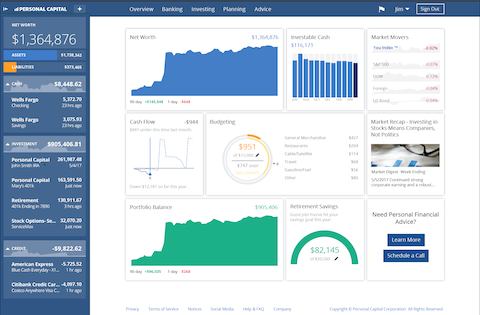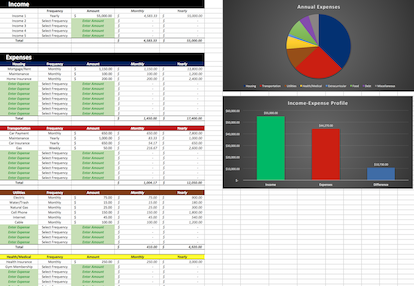
(Though it’s not required, it may be helpful to read my previous post about progressive taxes, before diving into this post.)
The Classic Comparison
The classic pre-tax (e.g. Traditional IRAs and 401(k)s) vs. Roth comparison usually goes something like this…
Assumptions
Initial Investment = $10,000
Tax Rate = 25%
Total Investment Return = 900% (i.e. 10x)
Pre-Tax Account
Pre-Tax Investment Amount = $10,000
Investment Balance Grows To = $10,000 x 10 = $100,000
Taxes On Withdrawal = $100,000 x 25% = $25,000
Final Balance = $100,000 - $25,000 = $75,000
Roth Account
Taxes owed = $10,000 x 25% = $2,500
After-Taxes Investment Amount = $10,000 - $2,500 = $7,500
Investment Balance Grows To = $7,500 x 10 = $75,000
Taxes On Withdrawal = $0
Final Balance = $75,000
In this scenario, it is shown that, all things being equal, the two investments result in an equal return.
Note: If the accounts from the investment example above were IRAs, the Roth account would be the winner. Roth IRAs enjoy a few additional advantages over traditional IRAs, including the flexibility to withdrawing contributions at any age without penalty (you cannot withdrawal any gains until 59.5) and the fact that they do not have required minimum distributions. If the investment return is the same, the Roth IRA is the better choice. Below, I’ll show you why the investment returns shouldn’t even be close however.
The analysis usually goes on to say that, ultimately the difference in the return on your investment will be determined by the tax bracket you fall into while working versus the one you’re in after you retire. If you fall into an equal or higher tax bracket in retirement, then a Roth account is the better option. If your tax bracket becomes lower in retirement, then a pre-tax investment account will provide the greatest benefit.
Though I think pre-tax vs. Roth comparisons that follow the formula I’ve laid out above provide a relatively accurate and easy to understand starting point for deciding what type of retirement account to choose, I also think they leave out some very important details. The most impactful piece of the equation that tends to be glossed over is the effective tax rate.
Effective Tax Rate
Typically, one marginal tax rate is selected and it is applied across the board (25% in the example above). In reality however, our progressive tax system provides an additional boost when money is invested in a pre-tax account. Not only is an investor’s taxable income lowered by the invested amount, but the actual effective tax rate decreases as well. This results in both a smaller amount and a smaller percentage owed in taxes. When all of the tax savings are also invested, the overall investment growth will increase significantly.
Income And Living Expenses
In addition to the oversight on the usage of marginal tax rates instead of effective tax rates, many also forget to consider the nature of income and living expenses before and after retirement when comparing pre-tax and Roth investments. If someone has a salary of $100,000 and he is able to save $25,000 each year, then that means the remainder ($75,000) is enough to cover all expenses and maintain his lifestyle. In order to maintain that same level of spending in retirement, he wouldn’t need to withdraw the amount of his previous salary (i.e. $100,000) from his retirement account, instead he would only need to withdraw enough to cover his living expenses (i.e. $75,000). For a pre-tax account, this means he would only be taxed on $75,000 in income each year, including in retirement. If this same person had invested in a Roth account, they would have owed taxes on the full $100,000 salary throughout their career.
When an individual maintains the same lifestyle (i.e. spending) in retirement that they had while working, the tax rate is lower by default since the income level is directly tied to the withdrawal rate. To put it in more understandable terms: the effective tax rate on a yearly $75,000 withdrawal in retirement would be lower than the effective tax rate on a yearly $100,000 salary while working.
This makes for an especially strong argument for choosing pre-tax investments, since it is usually suggested that a lower tax rate in retirement favor’s pre-tax investing. It should also be noted that, instead of increasing or even maintaining spending in retirement, most people tend to lower their spending on average. This only further bolsters the argument.
(If you’re a bit confused at this point, don't worry, I’ll work through some examples to clarify. These can be some tough concepts to grasp with words alone!)
A Better Comparison
So how would I do the comparison? I’m glad you asked! If it were up to me, it would go something like this…
Assumptions
Salary = $75,000
Living Expenses = $50,000
Investment Growth Rate = 10%
Roth Account
Step #1
Calculate the effective tax rate for a salary of $75,000 = 16.59%
Step #2
Calculate income taxes owed = $75,000 x 16.59% = $12,440 per year
Step #3
Calculate yearly Roth investment contribution by subtracting living expenses and income taxes from salary.
Yearly Roth Investment Contribution = $75,000 - $12,440 - $50,000 = $12,560 ($1,047 per month)
Step #4
Calculate the outcome for multiple time periods so we have multiple data points (I used an online investment calculator).
Roth 10 Year Performance
Total taxes paid = $124,400
Retirement Account Balance = $214,969
Roth 20 Year Performance
Total taxes paid = $248,800
Retirement Account Balance = $799,236
Roth 30 Year Performance
Total taxes paid = $373,200
Retirement Account Balance = $2,387,216
Pre-Tax Account
Step #1
Use a Federal income tax calculator to determine the lowest income one can have and still bring home enough, after taxes, to cover living expenses.
This is the step that almost every other pre-tax/Roth comparison misses. In my opinion, it’s the only way to accurately compare “apples to apples.” Skipping this step is a large part of the reason that most comparisons are a bit off.
It may take some experimentation to find the correct number.
Lowest Income That Leaves $50,000 After Taxes = $58,897
The calculator should also give you the effective tax rate. In this case, it is 15.11%.
Step #2
Calculate yearly pre-tax investment contribution by subtracting the income you determined in Step 1, from the total salary.
Yearly Pre-Tax Investment Contribution = $75,000 - $58,897 = $16,103 ($1,342 per month)
Step #3
Calculate income taxes owed = $58,897 x 15.11% = $8,897 per year
Note: We used the calculator in Step 1 to come up with $58,897; we did this specifically so that once taxes were subtracted, we would have enough to cover the scenario’s assumed living expenses. That is why $58,897 - $8,897 = $50,000.
Step #4
Calculate the outcome for multiple time periods so we have multiple data points (I used an online investment calculator).
Pre-Tax Account 10 Year Performance
Total taxes paid = $88,970
Retirement Account Balance = $275,539
Pre-Tax Account 20 Year Performance
Total taxes paid = $177,940
Retirement Account Balance = $1,024,426
Pre-Tax Account 30 Year Performance
Total taxes paid = $266,910
Retirement Account Balance = $3,059,831
Summary
| Roth | Pre-Tax | |
|---|---|---|
| Salary | $75,000 | $75,000 |
| Living Expenses | $50,000 | $50,000 |
| Pre-Tax Investment Contribution | $0 | $16,103 |
| Taxable Income | $75,000 | $58,897 |
| Effective Tax Rate | 16.59% | 15.11% |
| Income Taxes Owed | $12,440 | $8,897 |
| After-Tax Investment Contribution | $12,560 | $0 |
| Total Monthly Investment Contribution | $1,047 | $1,342 |
| Investment Growth Rate | 10% | 10% |
| 10 Year Investment Performance | $214,969 | $275,539 |
| 20 Year Investment Performance | $799,236 | $1,024,426 |
| 30 Year Investment Performance | $2,387,216 | $3,059,831 |
The Results
As the results demonstrate, when you invest in a pre-tax account (making sure to invest all of your tax savings as well), you end up with a much larger nest egg than you would have, had you chosen to invest in a Roth account. With a pre-tax account, you'll also pay significantly less in taxes leading up to retirement. Once you have retired and are ready to begin withdrawing your money, things get a little more complicated, however. For a Roth account, your tax obligations have already been met. The money you have saved can be withdrawn and spent with no additional taxes owed. The pre-tax account is different. Taxes are still a factor for any funds withdrawn from these accounts.
Notice that, for all time periods, the final pre-tax balance is about 28.2% greater than the final Roth balance. That means there would need to be an effective tax rate of at least 28.2% on any withdrawals from the pre-tax account, in order for the two investment options to be equal. Any effective tax rate less than 28.2% and the pre-tax investment comes out on top.
At current rates, a single individual would have to withdraw approximately $355,000 per year to have an effective tax rate that high (about double that amount for a married couple).
But maybe you think taxes will increase? Let’s say the government has added an additional 10% tax across the board by the time you retire. Income that under today’s policies has an effective tax rate of 18.2%, would now be taxed at 28.2% (18.2% + 10%). So how much would someone need to withdraw each year to have an effective tax rate of 18.2% today? About $100,000 per year (again, we can assume approximately double that amount for a married couple).
So even if the day the person from this scenario decided to retire, the government slapped down an additional 10% tax on all income, a pre-tax investment would still outperform a Roth investment, as long as their taxable withdrawals (i.e. spending) remained below $100,000 in todays dollars (~$200,000 for a married couple). This is literally double the $50,000 they need to fund their current lifestyle!
Note: Any tax deductions you might have in retirement, including the standard deduction, would allow you to increase your spending further.
Final Thoughts
I think we’ve clearly demonstrated that pre-tax investments have the potential to achieve far superior results when compared to Roth investments. When it comes to the reality of investing however, things may not be so clear.
Depending on your particular needs or simply your personality, it’s possible that a Roth account would be the better option for you. For example, if you know that instead of investing the tax savings you gain from utilizing a pre-tax account, you’ll just increase your spending, then maybe a Roth account is a better choice for you. Conversely, perhaps your goal is to be able to spend more while still saving; a pre-tax account could allow you to do this.
The point of this article is not necessarily to tell you which option is best for you individually. Instead, it was written to provide an unbiased analysis of these two commonly debated investment types, with the goal of showing which is the better performer when they are compared on equal terms. What do you think about the results?
Additional Note
One thing I didn’t talk about here but is worth noting is that it’s actually possible to convert pre-tax funds into Roth funds. Once you’ve retired, you can even leverage your deductions to avoid taxes on these conversions. If you’re able to apply this strategy effectively, it’s possible to achieve tax-free investments, tax-free gains, and tax-free withdrawals. I’ll definitely dive deeper into this concept in a future article.
Tools To Get You Started
Get a head start on your journey toward achieving financial independence by analyzing and tracking your income, expenses, investment performance, and overall net worth with the free online wealth management tool Personal Capital.
We use Personal Capital regularly to analyze our investment fees, track our investments, and project our net worth. We also periodically review our progress toward retirement with their retirement planning calculator.
If you’d rather do things on your own, become a subscriber today and you’ll receive our Free Financial Planning Dashboard. This tool allows you to enter your income and expenses to create a detailed budget. You can use it to track your spending habits over time or just to get an idea of where your money is going each month. Take a look at the automatically generated charts and you may discover you have a little more cash to invest than you thought.
If you’re interested in detailed instructions on how to budget, save, pay off debt, and invest, check out The 6 Phases of Building Wealth. This book provides step-by-step instructions for working through each “Phase” in the process of achieving Financial Freedom. If you're just starting out, the information in this book will provide you with an invaluable resource. You can pick up the digital version for only $2.99 on Amazon.
Disclosure: Some of the links found on this website may be affiliate links. Affiliate links pay GGD a small commission when you click through and/or make a purchase. This is at zero additional cost to you.
Full Disclaimer/Disclosure
Related Posts
-
Your Taxes May Be Lower Than You Think
Why Taxes? I recently had a discussion (debate) with a friend of mine comparing the benefits of pre-tax investments to those of Roth investments. I argued that, while there are many cases where Roth investing…
-
Investment Hierarchy: Top 7 Investments For Retiring Young
When you make the decision to become an early retiree, one of the first things you'll realize is that there are many, many different choices when it comes to investment accounts. 401(k), IRA, HSA, 457,…
-
Why 401(k)s Are The Best Investments, Period
There are plenty of great investment options out there to choose from, but very few can compete with the advantages of a 401(k). When you add in employer matching to the equation, I believe 401(k)s…







This seems like a lot of math so thanks for breaking it down!
Yep, there were a few tough calculations, I enjoy figuring this stuff out though. Thank you for reading Lynn!
I’m still a little confused. By pre-tax you mean a regular IRA instead of a Roth IRA, right?
Pre-Tax investments include retirement accounts like Traditional IRAs, 401(k)s, 403(b)s, and 457s. Roth investments include things like Roth IRAs and Roth 401(k)s.
This is a great example why traditional 401k and traditional IRA are superior vs the Roth 401k/ Roth IRA. Another reason why I like traditional, the government knows these traditional accounts hold a lot of taxes. If the stock market ever tanks again, the government would be forced to bail out the markets. The government will lose tax dollars if the market tanks. I believe in 2008, congress passed a law saying RMD’s were not required for that year. if the markets tank 50%, that is less tax money for the IRS to collect.